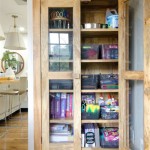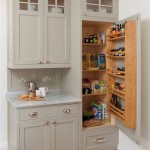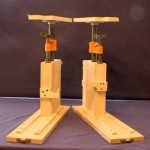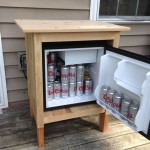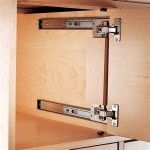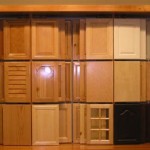DIY Cabinet Locks: Securing Your Home on a Budget
Ensuring safety within the home, particularly concerning children and vulnerable individuals, is paramount. Cabinets, often containing potentially harmful substances such as cleaning supplies, medications, and sharp objects, present a significant safety hazard if left unsecured. While commercially available cabinet locks offer a convenient solution, creating DIY cabinet locks can be a cost-effective and customizable alternative, especially for individuals with specific needs or unique cabinet designs. This article explores various methods for constructing DIY cabinet locks, outlining the materials required, the steps involved, and the benefits of each approach.
The need for cabinet locks extends beyond childproofing. They can safeguard sensitive documents, valuable items, and even food supplies from unauthorized access. In households with individuals experiencing cognitive decline, such as those with Alzheimer's disease, cabinet locks play a crucial role in preventing accidental ingestion of harmful substances or the unsafe use of household tools. The ability to customize DIY locks allows for adapting security measures to the specific risks present in a particular environment.
Magnetic Latches: A Simple and Effective Solution
Magnetic latches provide a relatively simple and inconspicuous method for securing cabinets. This approach utilizes a magnetic lock installed inside the cabinet and a corresponding metal plate attached to the door. When the door is closed, the magnet engages with the plate, holding the door securely shut. Opening the cabinet requires a strong magnetic key that overrides the latch's magnetic force. This system keeps cabinets secure while remaining relatively hidden from view, a desirable feature for aesthetic purposes.
The materials required for constructing a magnetic latch system are readily available at most hardware stores. You will need: a magnetic latch (available in various strengths), a corresponding metal strike plate, screws for mounting the latch and strike plate, a magnetic key (often included with the latch), and a drill with appropriate drill bits. Optionally, a template for marking screw holes can be helpful for accurate installation.
The installation process begins by determining the optimal placement for the latch inside the cabinet. Typically, this is near the top or bottom edge of the cabinet frame, ensuring it aligns correctly with the intended placement of the strike plate on the inside of the door. Using the drill and screws, securely mount the magnetic latch to the cabinet frame. Next, close the cabinet door and, using the magnetic key to engage the latch, carefully position the strike plate on the inside of the door. Mark the screw holes, and then attach the strike plate using the drill and screws.
After installation, test the latching mechanism to ensure it functions correctly. The door should remain securely closed when properly latched and open easily with the magnetic key. Adjustments to the position of either the latch or the strike plate may be necessary to achieve optimal performance. This type of cabinet lock is particularly useful for securing drawers and cabinets containing potentially dangerous chemicals or medications.
Hook and Eye Closures: A Robust and Versatile Option
Hook and eye closures offer a more visible but equally effective method for securing cabinets. This approach involves attaching a hook to the cabinet door and an eye to the cabinet frame. When the door is closed, the hook engages with the eye, preventing the door from opening. While less discreet than magnetic latches, hook and eye closures are more robust and can withstand considerable force, making them suitable for securing larger or heavier cabinet doors.
The necessary materials for creating hook and eye cabinet locks are simple and inexpensive. You will need: hook and eye sets (available in various sizes and finishes), screws for mounting the hooks and eyes, and a drill with appropriate drill bits. The choice of hook and eye size depends on the size and weight of the cabinet door, as well as the desired level of security.
Installation begins with determining the placement of the hook and eye. This is typically done near the top or bottom of the cabinet door and frame, ensuring proper alignment. Using the drill and screws, securely attach the hook to the cabinet door. Next, close the door and carefully position the eye on the cabinet frame, aligning it with the hook. Mark the screw holes, and then attach the eye using the drill and screws. Ensure that the hook can easily engage with the eye when the door is closed.
Following installation, test the closure to ensure it is secure. The door should remain firmly closed when the hook is engaged with the eye. For added security, consider using multiple hook and eye closures on a single door, particularly for larger cabinets. This type of cabinet lock is suitable for securing cabinets containing tools, equipment, or other items that require a higher level of security. You can also add a padlock through the eye of the closure for extra protection.
Repurposed Materials: Creative and Sustainable Solutions
Utilizing repurposed materials for creating cabinet locks not only promotes sustainability but also allows for unique and personalized solutions. Everyday objects can be transformed into functional and effective cabinet locks, reducing waste and saving money. This approach requires creativity and ingenuity, but the results can be both practical and aesthetically pleasing.
Many common household items can be repurposed for this purpose. For example, old belts, straps, or even pieces of fabric can be used to create simple latches. Wooden dowels or blocks can be fashioned into locking mechanisms. Even plastic containers or bottles can be cut and shaped to form secure closures. The specific materials required will depend on the chosen design and the available resources.
One example involves repurposing a leather belt. Cut the belt into appropriate lengths to reach around the cabinet doors you want to secure. Attach one end of each belt piece to the cabinet frame with screws or strong adhesive. Create a loop or slit on the other end of the belt piece. Then, attach a small knob or handle to the cabinet door at the point where the loop or slit will reach. To secure the doors, simply loop the belt around the knob or handle. This provides a basic yet effective means of keeping the cabinet doors closed.
Another option is to utilize wooden blocks and dowels. Attach a wooden block to the inside of the cabinet door. Drill a hole through the block. Attach another wooden block to the cabinet frame, aligning it with the block on the door. Drill a matching hole through this block. Insert a wooden dowel through both holes to lock the cabinet. This simple mechanism can provide a surprisingly secure closure. The length of the dowel will determine the level of security.
When using repurposed materials, it is crucial to prioritize safety. Ensure that all materials are clean and free from sharp edges or hazardous substances. Use appropriate fasteners and adhesives to ensure the locks are securely attached. Test the locks thoroughly to ensure they function correctly and provide the desired level of security. This method allows for the most customizable and innovative approaches to DIY cabinet security.
The choice of DIY cabinet lock depends on individual needs, the specific cabinet design, and the desired level of security. Magnetic latches offer a discreet and convenient solution, while hook and eye closures provide a more robust and visible option. Repurposed materials allow for creative and sustainable solutions, tailored to specific requirements. By carefully considering these factors, individuals can create effective and affordable cabinet locks to enhance safety and security within the home.

Easy Fix For Baby Latch Diy Stuff Proofing

Inexpensive And Effective Cabinet Lock For Baby Proofing Diy Stuff S

Mr Diy Drawer And Cabinet Lock 10330

Diy Child Safety Locks That Actually Work Instructables

Diy Baby Proofing S For Pas Child Guard Slider

Mr Diy Cabinet Latch 2pcs

Cabinet Door Lock Cupboard Drawer Box Diy Doors Locks

Diy Cabinet Lock Safe Rfid For Wooden Drawer E6t7

Wooch Electronic Cabinet Lock Diy Rfid With Usb Cable For Wooden Drawer Locker Cupboard Com

10 Clever Low Cost Diys To Baby Proof Your Home
Related Posts


